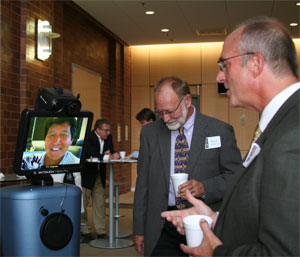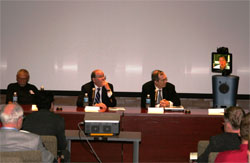Telemedicine Ignites Technology, Attracts a Crowd at UCI
By Anna Lynn Spitzer
|
09.21.06 – Progressive practitioners, a roaming remote-access robot and an intriguing topic drew a crowd of more than 100 from industry, academia and the medical community to Calit2@UCI last Thursday evening.
“Telemedicine Comes of Age: Supporting a New Model of Care with Network Technology,” the third in a series of “Igniting Technology” events, was cosponsored by Calit2 and law firm Knobbe Martens Olson & Bear LLP.
Guests got a close-up look at the emerging field that merges medical research and practice with the Internet, robotics and telecommunications. Moderated by Knobbe Martens partner Gerard von Hoffmann, the panel of UCI experts included urologist Ralph Clayman, pediatric neurologist Ira Lott, and Michael Berns, co-founder, chairman and CEO of the Beckman Laser Institute. A fourth panelist, Yulun Wang, joined the panel by remote presence from the headquarters of InTouch Health, his Santa Barbara-based medical robotics company. He was channeled by RP-7, a company-designed robot from which his face and voice emanated. InTouch Health has approximately 85 of the machines in hospitals across the country, enabling doctors to interact with patients from a remote location.
Wang, who also created the first FDA-approved surgical robot, could see and hear the Irvine audience as though he were in the room. He was connected to the discussion via broadband Internet and an 802.11 wireless network.
“The biggest challenge confronting health care today is not curing cancer, heart disease or Alzheimer’s, it’s serving an aging population with a reduced number of caregivers,” Wang told the crowd.
|
||||
InTouch Health’s remote-presence robots allow doctors to treat patients without necessitating bedside visits. “It enables critical care specialists to take care of patients more frequently and react quicker,” Wang said. “They can beam in for a few minutes, assess the patient and make necessary decisions.”
The robots can also be used to connect outlying areas to major medical centers, and to train medical students and clinical staff. “The possibilities will enable a worldwide interaction of clinical expertise,” Wang summarized. “It doesn’t matter if you live in a small town in Montana , you can still interact with the best specialists at UCI.”
Clayman, who performed the world’s first laparoscopic removal of a kidney for benign disease and for cancer, as well as the first laparoscopic removal of a kidney and ureter to treat cancer, told the audience that robots were slow to enter the medical field. In 1993, there were 20 million robots used in industry and only one in surgery he said. But endoscopic and laparoscopic surgery changed that, leading to the evolution of surgical robots, and then to telepresence in surgery, he explained. “A surgeon can put in the ports, insert the instruments, and then sit down at a console and operate from there. The console can be moved into another room, building, state or country.”
Clayman said robotic surgery not only affords doctors greater comfort, it decreases surgery time and error rates. Studies have shown that “surgeons are better with this robotic interface than they are without it.” Furthermore, he said, a study at Johns Hopkins indicated that patients actually like interacting with the robots in their hospital rooms.
Future applications for medical robots include military use in battlefield situations, thereby decreasing response time and increasing survival rates; and medical student/new doctor education. “I could sit in my office at UCI and watch a student in Indiana do his first laparoscopic radical nephrectomy,” Clayman said. “I could guide him through the procedure, maybe helping to eliminate errors.”
Ira Lott became interested in telemedicine about eight years ago for two reasons: a lack of practitioners in pediatric neurology; and the need for a way to make phase three clinical trials available to those living far away from academic medical centers.
From 2001 to the present, he has used telecommunications technology – including a polycom unit, television screen, phone lines and an ISDN connection – to hold 1,650 telemedicine clinics and conduct 6,050 consults in psychiatry and neurology.
In neuropsychiatry, telemedicine is used to evaluate stroke patients during the critical three to four hours post-stroke. New applications, including monitoring critical care with neurophysiologic data streams, are coming online, Lott said. “Doctors can look at patients with remote access and see their EEGs, oxygen saturation and other streaming data,” he said.
He believes that while telemedicine has many future applications, it must move from video conferencing equipment to a laptop computer platform. Systems must be easy to use and encrypted to ensure patient confidentiality, he added.
“The future of telemedicine in neurosciences is moving from isolated use to mainstream applications, toward hospitals that will be able to serve patients without any geographic barriers. It will have urban, rural and international applications.”
Michael Berns addressed a different kind of telemedical surgery – surgery on a cell. He works with lasers and associated optical technologies in biology, medicine and biomedical engineering, and uses high-speed networks to link distant labs together for image sharing and information exchange. “We use high-tech optical tools to operate inside a cell and we’re trying to make these techniques available to anyone around the world,” he said.
He described using laser beams to cut and move DNA, genes and other cell components. Among his favorite projects is one that measures the parameters of sperm motility using laser beams. He is using this research in conjunction with the San Diego Zoo to try to increase the fertility of endangered species.
He and colleagues at the Beckman Laser Center have developed a system called RoboLase. “You have a microscope and work station with sophisticated laser tweezers and scissors set up in one location, and through the Internet and wireless or wired connections, you can make these available all over the country and the world,” he explained.
To illustrate, he showed a video in which a colleague in Brisbane, Australia – with the aid of a 1-Gigabit-per-second line – was able to connect to an experiment in his Irvine lab on her computer. She was not only able to watch the experiment, but also participated in it by manipulating the laser tools from afar.
The message delivered to the intrigued crowd was that telemedicine will continue to improve and flourish.
Clayman perhaps summarized it best: “Robots do rule. You’re going to see more local and long-distance use, in clinical care and in the operating room. We’re just scratching the surface.”




